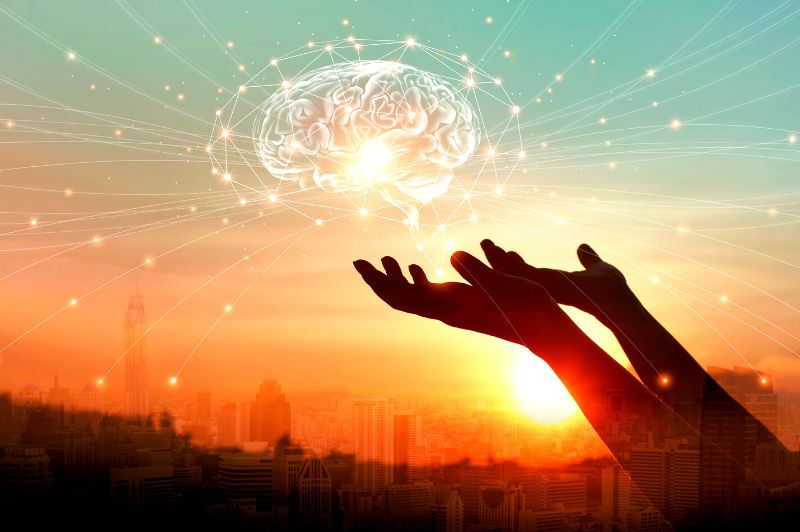Brain Health Expert: Patricia Faust
Have you ever considered that you need to work at making your brain see the positive side of life?
After all of the fear and angst that we have experienced over the past year our brains are heavily invested in the negative side of the story. Actually, our brains naturally shift to the negative. Our ancient ancestors needed to have their brains on high alert in order to survive. That hardwiring is still present in our brains today.
Because we stayed in the chronic stress zone for practically the entire time of COVID restrictions, we, unfortunately, created the neural pathways that keep us in that mindset.
Our Brains Are Having A Difficult Time Transitioning:
“I know it feels counterintuitive to work to make your brain be more positive.”
Now restrictions are lifting and there is sense of normalcy returning to our lives. But our brains are having a difficult time transitioning to this new, old normal. It is up to us to assist our brains in creating new neural pathways that will be attuned to the happier side of life. Where do you start when it is still hard to think positive?
Like everything else, this will be a process that demands practice. I know it feels counterintuitive to work to make your brain be more positive. Happiness and joy are feelings. And throughout our lives, we believed that we should experience them spontaneously.
Rick Hanson, Ph.D., a neuropsychologist focusing on hardwiring positive states of mind, wrote about the “7 Facts About the Brain That Incline the Mind to Joy”. I always appreciate information that guides you through unfamiliar practices, in order to change your brain.
Seven Brain Facts:
1. The Mind And The Brain Are Mainly (And Perhaps Entirely) A Single Unified System:
Everything we are aware of, including our own sense of self, has a one-to-one correspondence with underlying, physical, brain structures, and processes.
First, this means that, as your experience changes, your brain changes. It changes both temporarily – millisecond by millisecond, AND – it changes in lasting ways. For example, researchers have found that:
“Brains of taxi drivers in London are thicker in the regions that are key to visual-spatial memories.”
- Different mental activities change brainwave patterns.
- People who meditate have more of the vital neurotransmitter, serotonin.
- The brains of pianists are thicker in the areas of fine motor function.
- The brains of meditators are thicker in the regions engaged with sensory awareness and with the control of attention.
- Brains of taxi drivers in London are thicker in the regions that are key to visual-spatial memories.
- Traumatic experiences shrink the part of the brain responsible for storing new memories.
- Repeated episodes of depression create marked changes in the brain that make a person more vulnerable to depression in the future.
Second, as your brain changes, your experience changes. Studies have found that:
- Activating the left frontal regions leads to a sunnier outlook and a more positive mood – while strokes in those areas leave patients particularly irritable and depressed.
- Surges of the neurotransmitter, dopamine, feel very pleasurable (and why dopamine is associated with addictions).
- Damage to a cubic centimeter or so of tissue in a particular place on the left side of your brain can leave you able to understand the language but incapable of generating it, while damage just a few centimeters away will have the opposite effect.
- Electrically stimulating portions of the brain can trigger memories or even out-of-body experiences.
This understanding of the oneness of mind and brain spotlights a fantastic opportunity for wellbeing, psychological growth, and contemplative depth. In hundreds of ways, large and small, you can use your mind to change your brain to benefit your mind.
2. Neurons That Fire Together, Wire Together:
Psychologist, Donald Hebb, coined this phrase. It refers to the fact that the activation of a particular neuronal circuit increases the strength of the connections within the circuit.
The strengthening happens during tiny time intervals – through ephemeral electrochemical changes – and over longer periods as physically observable changes occur in the brain:
- Increased synaptic connections among neurons (synapses are the junctions between neurons: tiny gaps full of a rich soup of neurotransmitters like microscopic switches, on/off).
- Increased thickening of the glial cells, the scaffolding tissues that support neurons.
- Greater density of blood vessels bringing oxygen, glucose, etc. to neurons.
3. Fleeting Experiences Leave Lasting Traces In The Brain:
Since the mind and brain are one, the flow of information in the mind entails a corresponding flow of electrochemical activation through the neuronal circuitry of the brain.
This means that your experiences are important not just because of their brief effects on your momentary, subjective quality of life, but also because they produce enduring changes in the physical structures of your brain. And these can affect your wellbeing, functioning, and sometimes your physical health for days and decades to come.
“These can affect your wellbeing, functioning, and sometimes your physical health for days and decades to come.”
4. Most Changes In The Tissue Of The Brain Are Implicit Memory:
There are two kinds of memory: explicit and implicit
Explicit: Recollections of specific events
Implicit: Emotions, body sensations, relationship paradigms, a sense of the world.
Implicit memory is in your gut. It is visceral and powerful. What living feels like depends greatly on what is stored in your implicit memory. We are what we remember – the slowly accumulating registration of a lived experience.
5. Unfortunately, The Brain Emphasizes Negative Experiences:
It is the negative experiences that threaten our survival. So, our ancient ancestors that lived to pass on their genes paid a lot of attention to negative experiences. The same circuitry is loaded and fully operational in our brains today.
- First, the amygdala is neurologically primed to label experiences as frightening and negative.
- Second, when an event is flagged as negative, the amygdala-hippocampus circuitry immediately stores it for future reference. Then, it compares current events to the record of old, painful ones, and if there are any similarities, alarm bells start ringing.
- Your brain doesn’t go looking for what’s negative, it’s built to grab that information and never let go!
Positive Experiences:
Yes, we can notice positive experiences and remember them. But unless you are having a million-dollar moment, the brain circuitry for what’s positive is like paper-and-pencil compared to a high-powered video camera plugged into a fast computer with terabyte storage for what’s negative.
- Third, the negative generally trumps the positive. A single bad event with a dog is more memorable than 1000 good times.
- Fourth, your own personal training in the negative – whatever it has been – shapes your view of the world and yourself, and your personality and interpersonal style and approach to life.
All of this can lead to more of the negative showing up on your radar – either because you are scanning for it preferentially or unwittingly increasing the odds of it coming your way. This can make you more inclined to see the causes of the negative in the future. Even though the actual facts are that the vast majority of events and experiences in your life are neutral or positive.
“Even though the actual facts are that the vast majority of the events and experiences in your life are neutral or positive.”
6. You Can Help Emphasize And Store Positive Experiences Through Conscious Attention:
As you probably know – you remember something best when you make it as vivid as possible and then give it heightened attention over an extended period.
Here are three simple steps to change your brain:
- 1. Help positive events become positive experiences.
- Pay attention to the good things in your world, and inside yourself. Set a goal each day to look for something positive in your world.
- Decide to let yourself feel pleasure and be happy, rather than feel guilty about enjoying life.
- Open up to the emotional and sensate aspects of your responses to positive events, since is the pathway to experience things.
- 2. Extend the experience in time and space: savor and relish the positive experience.
- 3. Sense the positive experience soaking into your brain and body – register it deeply in your emotional memory.
7. Positive Experiences Have Many Important Benefits:
- Emotions organize the mind as a whole, positive feelings have global effects.
- They lower the stress response in your body by dampening the arousal of the sympathetic nervous system (fight or flight) and by activating the parasympathetic nervous system (relaxed and contented).
- They increase psychological resilience.
- Lift mood and protect against depression.
- Promote optimism.
- Over time, positive experiences help counteract the effects of trauma or other painful experiences. When you remember something painful from your past, your brain first reconstructs the memory – including its emotional associations. If you recall an event repeatedly with a dour, glum cast of mind, then your recollection of it will be increasingly shaded negative.
Emotional Charge:
Alternately, you can recall it repeatedly with a realistic upbeat state of being, then it will gradually come to mind more and more with a neutral quality. You will not forget the facts of what happened, but its emotional charge will slowly fade – and that can be a great relief.
They highlight key states of mind so that you can find your way back to them in the future. You can more readily tap into peace, contentment, feeling strong, well-being, etc.. Doing so can reward you for doing something that’s noble but not always easy, and thus support your ongoing motivation.
Focus On Positive Experiences:
The innate neurological circuitry of your mind poses a very real challenge: positive stimuli tends to roll through it while negative stimuli gets flagged and captured and deferred to. But you can consciously override those tendencies in simple and effective ways each day, by focusing on positive experiences, valuing them, and helping them sink in. (Rick Hanson, Ph.D., 7 Facts About the Brain That Incline the Mind to Joy)
The pandemic pulled the rug right out from under us. This article summarizes the WHY we are struggling and the HOW we can recover from all of the damage that we have suffered.
Reference:
Hanson, R. 7 Facts about the brain that incline the mind to joy.
Did you enjoy this article? Become a Kuel Life Member today to support our ad-free Community. Sign-up for our Sunday newsletter and get your expert content delivered straight to your inbox.

About the Author:
Patricia Faust is a gerontologist specializing in the issues of brain aging, brain health, brain function and dementia. She has a Masters in Gerontological Studies degree from Miami University in Oxford Ohio. Patricia is certified as a brain health coach and received a certification in Neuroscience and Wellness through Dr. Sarah McKay and the Neuroscience Academy. My Boomer Brain, founded in 2015, is the vehicle that Patricia utilizes to teach, coach and consult about brain aging, brain health and brain function. Her newsletter, My Boomer Brain, has international readers from South Africa, Australia, throughout Europe and Canada. She has also been a frequent guest on Medicare Moment on WMKV and Cincy Lifestyles on WCPO.






















